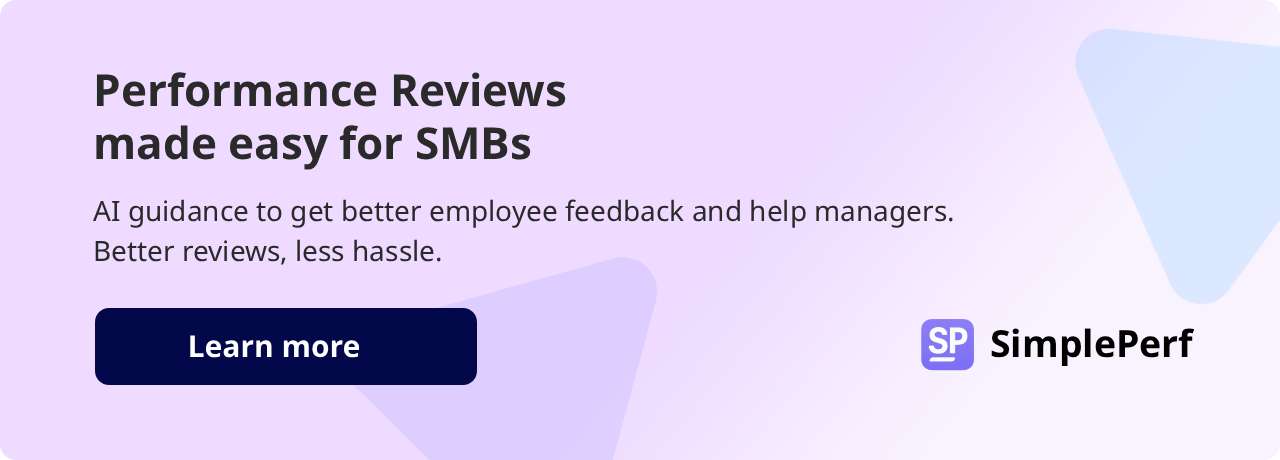What Is A Performance Review And How To Conduct Great Ones
Let’s discuss what went wrong with employee performance reviews and how you can conduct effective performance evaluations.

If you want a collective ‘eye twitch’ from both managers and employees, just mention the words ‘performance review’. As HRs, we see them all the time. But employee performance reviews shouldn’t be a forbidden word - they are the backbone of constructive feedback and improvement in employee performance. So, how did we get here?
We’ve recognized that mediocre performance appraisals are no longer enough, and change is needed. If you notice this too, let’s discuss what went wrong with employee performance reviews and how you can conduct effective performance evaluations. We aim to be transformational about it, so join us and let’s make this happen in 2025.

What is a performance review?
A performance review is an opportunity for managers to connect with their team members and discuss how the employee has been performing, keeping company values, and using opportunities for growth and development. The current performance review process can have many different types of formal performance meetings, such as:
- Monthly formal performance reviews
- Quarterly formal performance reviews
- Yearly performance reviews
- Ad hoc constructive feedback
- Customer and peer reviews (360 degree feedback)
- Development plan discussions
As HRs, we’ve seen a lot of sophisticated data and wonderfully designed documentation go into these performance review meetings. Yet, employees still emerge from them confused and underwhelmed a lot of the time. What’s the reason?
Why performance reviews work - and why they often don’t
Performance reviews tend to be a ‘hit-and-miss’ exercise. Sometimes, you conduct very effective performance reviews as a manager, and other times, they seem to go wrong for no apparent reason. Of course, when they do go wrong, they can have unintended consequences.
As can be seen above, performance reviews can have a tremendous impact on performance, staff morale, culture, managerial performance, and employee engagement. So we need to give this process the respect it deserves, if we want to build thriving companies that attract the best talent.
If this is your first performance review experience, we recommend you read: Why are performance reviews important + 3 tips to improve them, for more performance review tips.
How to build a great review system
Great performance reviews have a few key ingredients, just like a good recipe. After understanding why and how it can go wrong, it’s time to map out a process for conducting the kind of performance reviews you want to see in the workplace.
The ingredients for a great review
We’re off to a good start if you can pick up on where you may be going wrong and have the ingredients to improve on your past performance evaluations. Now let’s get down to the step-by-step of building this great review system.
1. Start with your ‘why’
Even a few years ago the primary concern in achieving business success was given over as: ‘Know your job, do your work, improve on your last performance review, and if a problem arises, solve it. But that’s not enough in a world increasingly filled with conflicting ideas, overwhelming amounts of information, and differing perspectives on how to get things done.
So, you need to start by asking a very basic and yet important question. Why?
Ask yourself why you’re conducting performance reviews in the first place. What’s the true motivation behind this process? If you know this, you’ll be completely transparent about the process you are setting up, and your employees will feel connected to what you’re doing.
When you encourage company-wide questioning of performance management practices, you will learn a great deal more than you bargained for, but that’s okay. You need this information, and the more specific the feedback is, the better. Avoid blanket statements about the process by applying the same strategy - ask why? - until you get a satisfactory answer.
Zone in on your high performers when you’re asking why. They are often the ones most invested in regular reviews, mostly because they take pride in their work. Their feedback WILL show up areas for improvement - guaranteed.
2. Identify what you’re measuring
A positive review and pointless performance metrics do not go hand-in-hand. That’s the brutal truth. After you’ve worked out why you do things (btw, throw out processes and actions that no longer work), you’ll know what to measure. Apply the rule of thumb: Measure what matters, and you won’t get off track.
When Alan Grove from Intel began teaching OKRs (Objectives and Key Results), he revolutionized measuring business success. John Doerr was so impressed with Grove’s techniques that he wrote the book Measure What Matters. It's worth a read if you want to measure the right things in your business and pull that through to the annual review. If you don’t have the time for reading, here are the key points:
- Objectives - What you want to achieve - make it ambitious (but not unobtainable), qualitative, and action-oriented.
- Key Results - What you want to measure - make it specific and time-bound. If it doesn’t have a number, it’s not a KR.
- Everyone’s OKRs should be transparent, creating accountability across all levels in the organization.
- OKRs should be regularly reviewed and updated, even quarterly, if this drives forward company goals.
- Measure stretch goals - this gives everyone something to aspire to.
- OKRs are most powerful when they align with company culture and values.
- Top-down buy-in and leading from the front are key for the entire organization to adopt OKRs.
Examples of OKR statements:
- Increase monthly recurring revenue by 20% in Q2.
- Improve demo to close rate from 25% to 35% in Q3.
- Reduce average sales cycle from 40 days to 20 days by November 2025.
- Grow organic traffic by 30% through SEO optimization.
- Launch v2.0 of the performance review upgrade by the end of Q2.
Software that can help you keep track of what’s important
If you’re already living in Slack, BuddiesHR’s performance review app will customize measurements and rating scales - helping you to measure what matters. HRs and managers will love using this app because:
- All the logistics for holding performance review meetings will be taken care of.
- Managers won’t need extra support from HR because BuddiesHR will do all the heavy lifting.
- The quality of your reviews will always be consistent, and you’ll be able to make salary and promotion decisions based on the data.
- The software is user-friendly, easy to implement and use, and highly customizable.
- The software was developed after consultation with top people leaders and advisors.
3. Create role-based review templates
Avoid using standardized templates for all the roles in your company. Your designers, sales people, marketing people, finance people, and management all contribute to the organization in a different way - or at least they should.
Once you know the whys and have worked out what you should measure, this part is much easier. All roles in your company must support the objectives you want to achieve. We’ll use an example most companies can relate to - a sales role.
Your why: Sustainable revenue growth quarter-on-quarter, and lasting customer relationships.
Your measurements: Closing rate, deal velocity, customer satisfaction, pipeline health.
Role-based review:
- Sales targets vs. actuals
- Client retention metrics
- 20-30 day sales cycle
- Demonstration of values like respect, integrity, adaptability, and persistence.
👉Further helpful information: Employee performance review templates

How an org structure supports role-based reviews
Mapping out your company’s org structure will be particularly useful during this exercise of working out role-based reviews. When you can see an overview of the roles you currently have and how they affect your bottom line, it’s easier to allocate the right OKRs to a role.
When you’re working on this, remember that you’re looking at roles needed to fulfill company objectives, not the people who are currently in the role and their skill level. The temptation to adapt the role to a person’s skill level is always there, but if you want to attain true success, avoid this at all costs. You can always train the person if their skills are not a match for the role.
With software from BuddiesHR, like Linky Directory, you can build your org chart in seconds, include any employee data that you want, and pave the way running smooth performance reviews. Combined with the BuddiesHR performance review app, Linky Directory gives you a complete solution for creating role-based templates according to your org chart and automating the performance review process.
GET STARTED WITH LINKY DIRECTORY
4. Set a regular and consistent review cycle
A once-a-year review cycle is outdated, and yet the main complaint of managers is that they don’t have the time to do more performance reviews. Between meeting company objectives, managing staff, completing spreadsheets, and hundreds of other tasks on the to-do list, a regular review cycle seems like a big ask.
The only viable solution to address this challenge is not to conduct fewer performance reviews, but rather to automate the work around it, and set up as many self-assessments as possible using a performance review software (as we have already discussed).
Ideally, you should have the following schedule:
As previously mentioned, consistent and regular feedback is important because it allows employees to improve their performance consistently and prevents surprises when annual performance reviews roll around.
5. Train your managers to deliver impactful reviews
If the person delivering the review fumbles the message, avoids difficult conversations, or leaves employees confused with conflicting feedback, you’re going to be back at square one with your performance review process.
Start with foundational skills. Equip your managers with the communication skills needed to deliver a clear, concise, and highly valuable review. This means roleplaying difficult conversations, learning to navigate defensive responses, and shifting to a coaching tone instead of a critical one.
Next, teach them to understand data intelligently. Even well-meaning managers can carry bias when looking at data. Whether it's proximity bias (favoring those closest to you), cultural bias, or recency bias (only remembering recent performance), these biases must be addressed by making managers aware of them.
Anti-bias training
Systems like BuddiesHR are designed to keep managers and employees on track with what the data actually reflects. By making it easy to understand and consistent, everyone on the team gets constant reaffirmation of what the data is saying.
Define performance review success
Carefully define what a successful review should look like. Compare this with what a terrible one looks like, and allow your managers to reflect on their own outputs when dealing with their staff.
By sharing examples of both, you can discuss how to achieve the one that has the best outcomes. Roleplay a great review in action, and allow them to mimic what it looks like. Keep going until everyone is comfortable that they can run a great review.
Provide the tools that allow everyone to bring their A-game
Any tools that can reduce the friction around getting prepared for the performance review will ultimately save your process. Struggling to schedule reviews, understand performance data, find last quarter’s feedback notes, or having a bad experience during coaching will cause your managers to procrastinate. Managers should be coaches, interviewers, and mentors, not administrators.
When you automate the logistics (with tools like BuddiesHR):
- Scheduling, reminders, and review notifications are done by the system.
- Work deadlines, blockers, and check-ins happen asynchronously.
- Employee reviews, past and present, are easily accessible.
- Self-reviews, peer reviews, or 360° feedback are set up for you.
With automation or semi-automation of the review process, your managers can focus on people, not processes.
👉 Further helpful information: AI in Performance Management: Strategic Use, Not Hype
6. Tie reviews to development plans
A truly impactful review should never leave your team members wondering what they can do with the feedback they’ve received. The end of the performance conversation should be the beginning of a development discussion, where you come up with actionable strategies for improvement with your staff member. Remember, there must be a two-way conversation because you will benefit from the insight too.
‘You’ve got potential, Joe!’ isn’t quite the motivating statement that it’s meant to be, if Joe walks away not knowing how to reach his ‘potential’. Here’s how you can end a review session by compiling a powerful action plan.
1. Turn all feedback into actionable, time-driven goals
Don’t let feedback just hang in the air; tie it to specific and clear goals that the employee must meet by the next review. Try something like this:
‘You’re really good at concluding the sales cycle in 20 days, and I know you have managerial aspirations, so let’s get you to mentor the junior sales people.’ or
‘You need to improve your client retention stats, so I’m going to pair with Steve, our top client retention consultant, for 2 weeks.’
2. Align development with career aspirations
Help your employees to see development plans as valuable documents (that actually come out of the desk drawer) by giving them sound advice for reaching their career milestones. Mapping out five or ten steps they can take until the next review gives them something to focus on. If they know they are steadily working their way towards a desired position or promotion, they will be more engaged in workplace activities.
3. Build the roadmap together
It shouldn’t be you telling your employees how to get promoted, and then dragging them there. The roadmap towards success must be a collective activity. Working together on this will strengthen team bonds and provide you with insight into your employees' thinking and aspirations. This is the kind of information you want, because it gives you ideas about how to handle future reviews.
Conduct great performance reviews now!
When Jim Collins wrote the popular book called Good to Great, he postulated that good is the number one enemy of great. By this statement, he challenged companies to move past complacency into a process of continual improvement. He suggested that consistency, discipline, incremental improvements, and enduring values build the path from good to great.
It’s these same principles that undergird the process of great performance discussions. You can apply them immediately and see not only business results move forward, but also the level of employee engagement. By transforming your review process, you’ll be working your way towards being a great company too.
Finalize the entire process by incorporating the latest performance management technology to truly give your business a competitive edge. You need a partner that understands where you’re going and how to get you there - one that has already seen the same vision - that’s BuddiesHR. We said at the start that we aim to be transformational - we hope you’ll join us.





